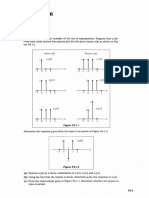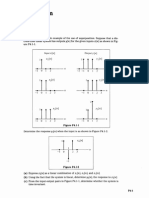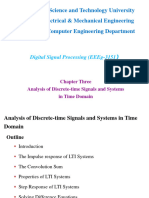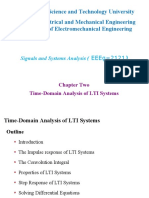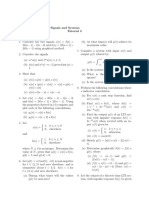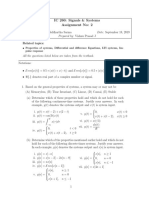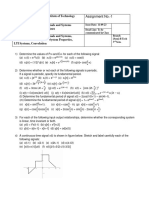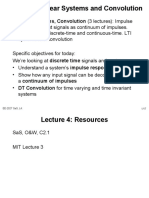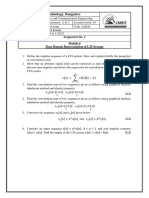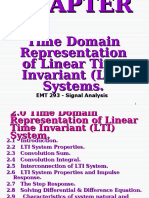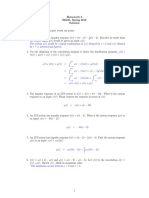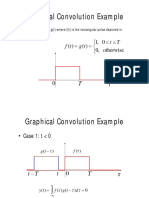0 ratings0% found this document useful (0 votes)
148 views12 pagesProblemSets Chap2-Haykin VanVeen
Uploaded by
Jerry JosephCopyright
© © All Rights Reserved
We take content rights seriously. If you suspect this is your content, claim it here.
Available Formats
Download as PDF or read online on Scribd
0 ratings0% found this document useful (0 votes)
148 views12 pagesProblemSets Chap2-Haykin VanVeen
Uploaded by
Jerry JosephCopyright
© © All Rights Reserved
We take content rights seriously. If you suspect this is your content, claim it here.
Available Formats
Download as PDF or read online on Scribd
You are on page 1/ 12
Additional Problems 183
3. Applications of difference equations to signal-processing problems and block diagram.
descriptions of discrete-time systems are described in the following texts:
» Proakis, J. G., and D. G. Manolakis, Digital Signal Processing: Principles, Algorithms
‘and Applications, 3rd ed. (Prentice Hall, 1995)
> Oppenheim, A. V., R. W. Schafer, and J. R. Buck, Discrete Time Signal Processing,
2nd ed. (Prentice Hall, 1999)
Both of the foregoing texts address numerical issues related to implementing discrete-time
TI systems in digital computers. Signal flow graph representations are often used to describe
implementations of continuous- and discrete-time systems. They are essentially the same as
a block diagram representation, except for a few differences in notation.
4. In this chapter, we determined the input-output characteristics of block diagrams by ma-
nipalating the equations representing the block diagram. Mason's gain formula provides a
direct method for evaluating the input-output characteristic of any block diagram repre-
sentation of an LTI system. The formula is described in detail in the following two texts:
> Dorf,R.C, and R. H. Bishop, Modern Control Systems, 7th ed. (Addison-Wesley, 1995)
» Phillips, C. L, and R..D. Harbor, Feedback Control Systems, 3rd ed. (Prentice Hall, 1996)
5, The role of differential equations and block diagram and state-variable descriptions in the
analysis and design of feedback control systems is described in Dorf and Bishop and in
Phillips and Harbor, both just mentioned.
6. More advanced treatments of state-variable-description-based methods for the analysis and
design of control systems are discussed in.
> Chen, C. T., Linear System Theory and Design (Holt, Rinehart, and Winston, 1984)
» Friedland, B., Control System Design: An Introduction to State-Space Methods
(McGraw-Hill, 1986)
A thorough, yet advanced application of state-variable descriptions for implementing discrete-
time LTI systems and analyzing the effects of numerical round-off is given in
» Roberts, R. A., and C. T. Mullis, Digital Signal Processing (Addison-Wesley, 1987)
[4xermonat Prosiems
2.32
2.33
‘A discrete-time LT system has the impulse response
‘(7 depicted in Fig. P2.32(a). Use linearity and time
invariance to determine the system output y{7t ifthe
inpuris
(a) x(n] = 36[n) - 28{n - 1)
(b) x{n] = af + 1) — wl — 3]
(c). x{m] as given in Fig, P2.32(b).
Evaluate the following discrete-time convolution
sums:
(a) y{m] = u[n + 3) *u[n — 3]
(b) y{n] = 3*u{-n + 3] «uf — 2]
[nm] * u[n + 2)
n)u(n] «uf — 1)
1)" » 2u[-n + 2] Ficure P2.32
(CHAPTER 2 1 TiME-DOMAIN REPRESENTATIONS OF LINEAR TIME-INVARIANT SYSTEMS
(6) yf] = cos($n) (3)"m[n — 2]
(6) yn) = Bru{n] *ufn- 3, al <1
(h) y[#] = B"«[n] * a*u[n — 10), Ial <1,
lal <1
(uf + 10] - 2u[n}
+ ulm — 4]) + u{n = 2)
Gym) = (ulm + 10) ~ 20 (n]
+ ulm —4))*B%{n), |pl" ce ”
a bn rete) le al wo Soe +240 +910 = Sai)
(&) bf) = wale)
(e) b(t) =e* Rg
Hy = 8%)
(@) b(2) = (1/4)(u(2) ~ w(t ~ 4)
(hy (2) = ais)
Suppose the multipath propagation model is gener-
alized to a k-step delay between the direct and it
rect paths, as given by the input-output equation
(t) + of ole) + 8y(0) = Salo
At) + af et) + 2y(0) = x(0)
x0 wo | 3e c
®
yl] = x{n] + ax[n ~ k). -
Find the impulse response of the inverse system. ww pees a
Write a differential equation description relating the .
output to the input of the electrical circuit shown in.
(a) Fig. P2.52(a) ©
(b) Fig. P2.52(b) Ficune P2.52
254
2.55
256
257
Additional Problems
Determine the homogeneous solution for the systems
described by the following difference equations:
(a) yf] = yf ~ 1] = 2e[n]
(by yf") - Syl - 1] - bol - 2] = afm]
+x[n-1]
ieyln — 2] = x[n - 1]
+ dyfm — 2] = afm]
+ 2x{n—1]
Determine a particular solution for the systems de-
scribed by the following differential equations, for
the given inputs:
54 + 1040 = 2)
©) yin) +
(a) y{n7) + yf - 1]
S50 + 40 = 32009)
(i) x(t}
(ii) x(¢
(ii) x(4) = (cos() + sin(2))
Zo + 2559 + 910 = Sec)
(i) x(t) = eu (t)
(ii) x(t) = 2e*u(e)
(iil) x(t) = 2 sin(#)
Determine a particular solution for the systems de-
scribed by the following difference equations, for the
Gren ingecs
(a) a(x) ~ fm ~ 1] = 2e(n]
@ xn
(ii) x[n] =
(iii) x[m] = cos(Fn)
vin] = Sym = 1] = bole = 2] = at)
+x{n—1]
O)
ylm] + afm — 1] + ylm — 2] = fn]
+2x[n -1]
(i) x(n] = u[n)
«iy x{n] = (Z')"aln]
Determine the output.of the systems described by
the following differential equations with input and
initial conditions as specified:
258
259
2.60
2.61
4
x(t) = w(t)
) Soo + S90 + 410 = Le00,
HO) = lee = 1,x(t) = sin(t)u(t)
© Se + 64909 + 8909 =
2x(t),
HO) = “Ae Sy(rae= Lx() = 6M)
S90 +90 = 340,
HO) = 1, Lycee = Aya) = 20)
Identify the natural and forced responses for the sys-
tems in Problem 2.57.
Determine the output of the systems described by
the following difference equations with input and
initial conditions as
pla i=
(a) yf] —
fe) yn] + tof" ~ 1) -
+a[n—1},
WA] = 4,912] = —2yxn] = (1) al]
|dentify the natural and forced responses for the sys-
tems in Problem 2.59.
‘Write a differential equation relating the output y(t)
to the circuit in Fig. P61, and find the step response
by applying an input x(t)'= u(e). Then, use the step
response to obtain the impulse response. Hint: Use
principles of circuit analysis to translate the t = 0
initial conditions to t = 0* before solving for the un-
determined coefficients in the homogencous compo-
nent of the complete solution.
og peor ve
Ficure P2.61
2.62
Use a first-order difference equation to calculate the
monthly balance on a $100,000 loan at 1% per
month interest, assuming monthly payments of
$1200. Identify the natural and forced responses. In
this case, the natural response represents the balance
190
2.63
2.64
2.65
2.66
2.67
(Cuarren 2 = Time-Domain REPRESENTATIONS OF LINEAR TIME-IWWARIANT SYSTEMS
of the loan, assuming that no payments are made.
How many payments are required to pay off the loan?
Determine the monthly payments required to pay off
the loan in Problem 2.62 in 30 years (360 payments)
and in 15 years (180 payments).
‘The portion of a loan payment attributed to interest
is given by multiplying the balance after the previous
payment was credited by Thi» where ris the rate per
period, expressed in percent. Thus, if {7 isthe loan
balance after the mth payment, then the portion of
the nth payment required to cover the interest cost is
y(n — 1](7/100). The cumulative interest paid over
payments for period through 1 is thus
(7/100) & y[n - 1).
Calculate the total interest paid over the life of the
30-year and 15-year loans described in Problem 2.63.
Find difference-equation descriptions for the three
systems depicted in Fig, P2.65.
2
=
@
x0] 18] 2-5} 900)
cle erelet,
Ficune P2.65
Draw direct form I and direct form Il implementa-
tions for the following difference equations:
(a) yf) — dy — 1) = 6x]
(b) yf) + $yfm = 1) - fl - 2) = xf]
+ 2x{n 1)
(©) y{m] ~ yf ~ 2] = x[n - 1)
(4) y(n] + Syl - 1) - yf — 3] = 3x - 1)
+ 2x{n- 2)
Convert the following differential equations to inte-
‘gral equations, and draw direct form I and direct form
implementations of the corresponding systems:
(a) So + 10y(t) = 2x(2)
& d
() Fant) + SH a0) + (8) =
&
(o 09 +909 = 350)
& da d
(a) ge + 2p + 3y(t) = x(t) 3g)
2.68 Find differential-equation descriptions for the two
systems depicted in Fig. P2.68.
~~
®
Ficure P2.68
* 2.69 Determine a state-variable description for the four
liserete-time systems depicted in Fig. P2.69.
2
[ea oe
a(n) ye stn
2
®
xin
tr
Ficune P2.69
Additional Problems 191
2.70 Draw block diagram representations corresponding 2.72 Draw block diagram representations corresponding
to the discrete-time state-variable descriptions of the to the continuous-time state-variable descriptions of
following LTI systems: the following LTI systems:
1 1
. a-[] »-[3}
e=[1
"
z
Sue
ieee
e
u
ca
e-f1 + D
wa-[? “th b
c=[1 0) D
00
wan[? oh of
=[1 -1} D
2.71 Determine a state-variable description for the five
continuous-time LTI systems depicted in Fig. P2.71.
.
Lo 2 4
@
x10.
Fioune P2.71
192 (Carren 2 = Time-Domain REPRESENTATIONS OF LINEAR TIME-INVARIANT SYSTEMS
2.73 Let a discrete-time system have the state-variable (b) Define new states gi(t) = 4u(+) ~ aa(t)s
description given by h(t) = 2q;(t). Find the new state-variable de-
scription given by A’, b’, c’, and D’.
1 -} 1 (6). Draw a block diagram corresponding to the new
A=|i gh b=|o/ state-variable description in (b).
(4) Define new states i(t) = 3,41(¢),42(#) =
{1-1 and D = (0). baqi(t) — b\q,(t). Find the new state-variable
description given by A’, b’, c’, and D’.
(c) Draw a block diagram corresponding to the new
(a) Define new states qi(n] = 2qi{n),qi[n] =
pr care celery a acc state-variable description in (d).
(b) Define new states gi[n] = 3q:{n],qi["] = o—m
2qi[n]. Find the new state-variable description fe os
given by A’, b’, e’, and D’. 1/7
(c) Define new states qi[n] = ai[n] + arln],ail7] i — x0
= qiln] — a(n). Find the new state-variable
description given by A’, b’,c’, and D', ® Z
2.74 Consider the continuous-time system depicted in om,
Fig. P2.74,
{a} Find the state-variable description for this sys- LJ
tem, assuming that the states q,(t) and qa() are
as labeled. Froune P2.74
[Aovxcen Prostems
2.75 In this problem, we develop the convolution integral
‘using linearity, time invariance, and the limiting form
ofa stair-step approximation to the input signal. To-
ward that end, we define ga(t) as the unit area rec-
tangular pulse depicted in Fig. P2.75ta).
(a) A stairstep approximation to a signal x(t) is
depicted in Fig, P2.75(b). Express ¥(t) as a
‘weighted sum of shifted pulses gs()- Does the
quality of the approximation improve as 4
decreases?
(b) Let the response of an LTI system to an input
g(t) be hs(t). If the input to this system is
(8), find an expression for the output of the
system in terms of ha().
(c). Inthe limie as A goes to zero, ga() satisfies the
properties of an impulse, and we may interpret
1b(t) = limy_sohg(t) as the impulse response of
the system. Show that the expression for the sys-
tem output derived in (b) reduces to x(t) * b(t)
in the limit as A goes to zero.
2.76 The convolution of finite-duration discrete-time sig-
nals may be expressed as the product of a matrix
and a vector. Let the input x{7t) be zero outside of
n= 0, 1,...L ~ 1 and the impulse response h{n] »
zero outside of = 0, 1,...M — 1. The output
y(n] is then zero outside of
Additional Problems
L + M~1.Define column vctorex = [x{0],2{1}, 2.80 Light
AL aFandy= f0h{1} 90M = 11)
Use the definition of the convolution sum to
matrix H such that y = Hix.
‘Assume thatthe impulse response of a continous-time
system is zero outside the interval 0 < t < T,.Usea
Riemann sum approximation to the convolution in-
tegral to convert the integral to a convolution sum
that relates uniformly spaced samples of the output
signal to uniformly spaced samples ofthe input signal.
The cross-correlation between two real signals x(¢)
and y(t) is defined as
a(t) = ie ” x(s)y(r — fide.
This integral isthe area under the product of x(t) and
a shifted version of y(t). Note that the independent
variable 7 — {i de eg of hat found nthe de
finition of convolution. The autocorrelation, r.(1
Spal sp) nobeined by seplcne yi Rete
(a) Show that r(t) = x(t) + y(—t)
(b) Derive a step-by-step procedure for evaluating
the cross-correlation that is analogous to the
procedure for evaluating the convolution inte-
‘gral given in Section 2.5.
Evaluate the cross-correlation between the fol-
owing signals:
(i) x(t) = u(t), 9(0) = u(t)
(ii) x(t) = cos(wt)[u(t + 2) ~ u(t - 2)},
y(t) = cos(2at)[u(t + 2) ~ u(t ~ 2)]
(ii) x(t) = w(t) — u(t — 1) + u(t 2),
y(t) = w(t + 1) = a(t)
(iv) x(t) = u(t — a) ~ u(t - 2-1),
y(t) = w(t) ~ w(t ~ 1)
Evaluate the autocorrelation of the following
signals:
(i) x(t) = “u(t
(i)_x(t) = cos(wt)[u(e + 2) ~ u(t - 2)]
(it) x(t) = u(t) = 2u(e = 1) + u(t - 2)
(iv) x(t) = u(t — a) u(t - @ = 1)
(e) Show that r,,(t) = rat).
(6) Show that ret) = rex(—#).
Prove that absolute summability of the impulse re-
sponse isa necessary condition for the salty of
a discrete-time system. (Hint: find a bounded input
ln] sich that he outa at sme ime ati
a lo[k}L)
3)
(a)
2.81
193
with a complex amplitude f(x, y) in the xy-
propagating over a distance d along the z-axis
in free space generates a complex amplitude
sean=[" [hey me-x,y-y) de ay,
bx) = hye Mern4,
‘Where k = 2/Ais the wavenumber, Ais the wave-
length, and hy = j/(Ad)e™. (We used the Fresnel
approximation in the expression for g.)
(a) Determine whether free-space propagation rep-
resents a linear system.
(b) Is this system space invariant? That is, does 2
spatial shift ofthe input, f(x — xo,y — Jo) lead
to the identical spatial shift in the ourput?
(c)_ Evaluate the result of a point source located at
(1,91) propagating a distance d. In this case,
fxy) = 8(x = xy 5% where 5(x,y) is
the two-dimensional the impulse. Find
the: ing two-dimensional impulse re-
sponse of this system.
Evaluate the result of two point sources located
at 2 Gon) and (x2,92) and propagating a
@
Toca depicted in Fig P2-81
ia be ved bythe pl fie il equation
Zany =r,
phere 7) inthe iplaceen expres a fone
of position I
‘and time ¢ and cis a constant de-
termined by the material proper of the suing. The
initial conditions may be specified as follows:
WO)=0, y(at)=0, > 0;
(1,0) =x(I), O
You might also like
- Discrete-Time Signals & Systems ProblemsNo ratings yetDiscrete-Time Signals & Systems Problems51 pages
- Topic 5 System Properties and Convolution SumNo ratings yetTopic 5 System Properties and Convolution Sum5 pages
- Chapter 3 Analysis of Linear Time Invariant Systems (Complete) - UpdatedNo ratings yetChapter 3 Analysis of Linear Time Invariant Systems (Complete) - Updated13 pages
- SYDE 252 Linear Systems and Signals Fall 2005 Professor Ed Jernigan Systems Design Engineering University of WaterlooNo ratings yetSYDE 252 Linear Systems and Signals Fall 2005 Professor Ed Jernigan Systems Design Engineering University of Waterloo70 pages
- EE21201/EE21101: Signals and Systems Instructor: Prof. Ashish R. HotaNo ratings yetEE21201/EE21101: Signals and Systems Instructor: Prof. Ashish R. Hota46 pages
- Lecture 4: Linear Systems and ConvolutionNo ratings yetLecture 4: Linear Systems and Convolution17 pages
- Time Domain Representation of Linear Time Invariant (LTI) SystemsNo ratings yetTime Domain Representation of Linear Time Invariant (LTI) Systems54 pages
- LTI Systems: Impulse Response SolutionsNo ratings yetLTI Systems: Impulse Response Solutions12 pages
- Integrated Dual Degree (B.Tech.+M.Tech.) Examination Electronics & Communication EngineeringNo ratings yetIntegrated Dual Degree (B.Tech.+M.Tech.) Examination Electronics & Communication Engineering4 pages
- Name: 25 February 2015 EE301 Signals and Systems Exam 1 Cover SheetNo ratings yetName: 25 February 2015 EE301 Signals and Systems Exam 1 Cover Sheet14 pages
- Graphical Convolution Example: T T T G T FNo ratings yetGraphical Convolution Example: T T T G T F22 pages
- Graphical Convolution Example: T T T G T FNo ratings yetGraphical Convolution Example: T T T G T F22 pages
- Time Domain Representation of Linear Time Invariant (LTI)No ratings yetTime Domain Representation of Linear Time Invariant (LTI)51 pages
